The Video Game What Remains of Edith Finch is a Deeply Impactful & Emotional Experience – So Nice, I Played It Twice!
What Remains of Edith Finch is a 2017 adventure game developed by Giant Sparrow and published by Annapurna Interactive. The game is a collection of short stories, each one telling the tale of a different member of the Finch family and their untimely death. The player controls Edith Finch, the last surviving member of the family, as she explores her family’s history and tries to understand why she is the only one left alive.
The game is notable for its unique storytelling approach, which uses a variety of gameplay mechanics to tell each story. For example, one story is told through a series of paintings, while another is told through a first-person shooter. The game’s art style is also very distinctive, with a hand-painted look that gives the game a dreamy feel.
What Remains of Edith Finch was praised for its originality, its emotional impact, and its beautiful art style. The game won numerous awards, including the BAFTA Award for Best Game. You can read more about the developers’ full intent, and some of their inspiration for the game in this article upon its initial debut-time. I found this article to be so endearing! The story behind the haunting What Remains of Edith Finch | VentureBeat
Exploring the Relations to Mental Illnesses as Seen Through the Stories of the Finch Family’s Strongest Trauma Bond – the Norwegian Finch Curse.
The legend of the Norwegian Finch Curse is a fictional story that originated from the video game. A tapestry of interconnected stories, the Finch Curse casts a long shadow over the Finch lives, instilling a constant fear of its inevitable influence.
The game’s narrative forces the player to navigate the Finch family’s fragmented history through peepholes on locked doors. For me, this served as a stark reminder of the assumptions we can make based on limited information. Also, the peepholes too offer glimpses into a characters’ inner struggles, highlighting the diverse manifestations of mental health issues on a person in these kinds of extreme environments. The house itself, a patchwork of memories and materials, symbolizes the compartmentalization of trauma. Each room represents a different perspective on the family’s tumultuous past, and this is what therapy has felt like for me lately. Opening a new door, with new information, to make similar connections to the ultimate truth – death comes for us all.
Some of the game’s mechanics, particularly during Molly’s shapeshifting story, mirror the disorientation and loss of control often associated with having or living with someone with mental illness. During the cannery scene, the art style makes visual what most of us feel as we doom scroll and daydream into our screens and illudes to the devasting consequences of this kind of distraction from our realities. Overall, recurring themes of lack of control, paranoia, depression, fighting for control, or the struggle to reconcile with one’s past constantly returns the player into a resilient perspective of blissful ignorance.
The Norwegian Finch Curse serves as a powerful metaphor for the interconnectedness of the family unit, their fates intertwined by a shared legacy of pain. It is a poignant reminder of the devastating impact trauma can have on individuals and their families. There will always be an internal struggle between knowing your history and not knowing for your own sense of control, based on the stories we have been given. Our power and innate resilience comes from the ability to write it for ourselves.
Edith Finch is an Examination on How Family Stereotypes & Traumas Can Be Supported by/ Ignored by People Claiming to Want to Break Free
There is reason to hope for healing beyond anger and grief.
What Remains of Edith Finch’s true gaming essence lies in its exploration of life’s inherent resilience – the innate ability to persevere despite overwhelming challenges. The Norwegian Finch Curse, though a fictional construct, serves as a poignant reminder of the enduring human spirit. I feel the game does a good job at highlighting those who were making the best of things with a compassionate view. Through the Finch family’s life stories, we can feel a range of grief, anger, confusion, and sadness for each individual. The empathy felt for even some of the lesser likeable characters is what still sticks with me – years later. I think this is because of my own growth and understanding of what family means to me. Particularly, I have felt the pains of generational poverty and violence and the survivor’s guilt of the other side. This led me to researching online, and talking with my therapist about, one thing only – are families with these traumas truly doomed in a cycle of their own best- or worst-case scenarios? And what is the hopeful message for those seeking their own new paths out of their own Finch curse?
Chronic stress can have a profound impact on individuals and families. These stressors can be seen in families across generations: poverty, violence, dishonesty. While individual treatment methods are gaining traction, addressing chronic family stress remains a crucial area of intervention. Through my own personal journey and experience, in the video game and in my real life, I have felt the profound impact of both sides. What Remains of Edith Finch reminded me that healing and rebirth is possible – especially in times of feeling broken and incomplete.
By collectively reducing stress and enhancing family resilience, three key benefits can be achieved:
- 1) accelerated recovery for PTSD and family trauma sufferers,
- 2) a conducive environment for healing and personal growth, and
- 3) a shift in family response patterns to challenges, potentially mitigating future stress-related disorders.
While the Norwegian Finch Curse is a fictional story, it is a powerful and evocative one that has resonated with many. The “curse” is a reminder of the dangers of unresolved trauma, and therefore creates the family-system of stress that can leave lasting impacts on personalities, through entire generations. It is an emotional call to us to seek help and support if we are struggling with the effects of past experiences.
Going forth for the sake of it because no one can tell your story but you!
You can read more about approaches to therapy with family-unit focuses here: Trauma and the Family: A Systems‐oriented Approach (researchgate.net) If you or someone you know is looking for support or struggling with mental illness or abuse - please visit the NAMI Helpline. Like and subscribe to my Youtube for more gaming content like this!




